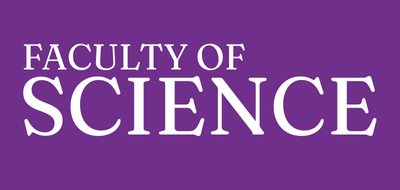Safe havens: Conserving endangered Clanwilliam sandfish, pool by pool

PhD candidate Cecilia Cerrilla (Department of Biological Sciences) measures a sandfish, a critically endangered large-bodied freshwater fish found in only one catchment area of the country the Doring River and its tributaries, the Biedouw and the Oorlogskloof Rivers.
Sarah Fransman remembers when spawning Clanwilliam sandfish arrived in the Biedouw Valley near Clanwilliam. The thousands-strong shoal creating wavelets along the surface of the Biedouw River, fish packed on top of one another, Fransman said. “Dit was wonderlik om dit te sien in die water.” (It was wonderful to see it in the water.) Now the fish are scarce.
Fransman’s memory reaches far back, as does local farmer Willem van Zyl’s. Tramping down the dry riverbed, on the family farm in the Oorlogskloof River Valley near Vanrhynsdorp, he points to a juncture of dark rock where the Oorlogskloof River, a tributary of the Doring River, flowed fast for two or three months of the year after winter rains, and the spawning fish migrated upstream in August and September each year. Locally known as “onderbekvis” to describe a “down-turned hoover-like mouth”, they were abundant then, said Van Zyl.

Adult sandfish migrate into the Biedouw River to spawn in spring.
“The Oorlogksloof River still flows in the winter and spring, but fewer pools remain through the summer, about half as many remain through the summer compared to before 2015 when the drought set in,” said Cecilia Cerrilla, a University of Cape Town (UCT) PhD candidate.
Multi-faceted rescue campaign
Fransman and Van Zyl feature in a new documentary series, Saving Sandfish, a 10-part web series produced by Dr Otto Whitehead and Dr Jeremy Shelton, part of a National Geographic Society-funded programme of conservation, engagement and research to preserve one of the country’s most threatened large-bodied freshwater fish.
Supporting this multifaceted programme is a research initiative spearheaded Cerrilla. Her focus is on the added threat of invasive fish species to the sandfish’s remaining habitats.
It’s a worldwide problem highlighted by a research paper on which she is lead author. Titled “Rapid population decline in one of the last recruiting populations of the endangered Clanwilliam sandfish (Labeo seeberi): The roles of climate change and non-native fish”, the paper draws on her master’s research in the Department of Biological Sciences at UCT and has been published in Aquatic Conservation: Marine and Freshwater Ecosystems.

The Heuningvlei community working together to assist with the 2021 sandfish rescue in the Biedouw River.
Three non-native fish species are found in the Oorlogskloof River, home to one of the last recruiting populations of sandfish. These are smallmouth bass (Micropterus dolomieu), bluegill sunfish (Lepomis macrochirus) and banded tilapia (Tilapia sparrmanii).
Tilapia and sunfish were introduced to local rivers as fodder fish for bass, which were introduced to the Olifants/Doring River system in the 1930s as a sportfish, said Cerrilla. But the bass and sunfish have had a catastrophic impact on young sandfish.
Invaluable data sets
Cerrilla’s major contribution to the conservation project has been on the research side. For her recent paper she analysed an “incredibly” valuable six-year data set collected over nine years across 25 km of the Oorlogskloof River. The figures are alarming, showing a 92.6% decline in the relative abundance of sandfish between 2013 and 2018, precipitated by a 99.6% decline in young-of-the-year individuals.
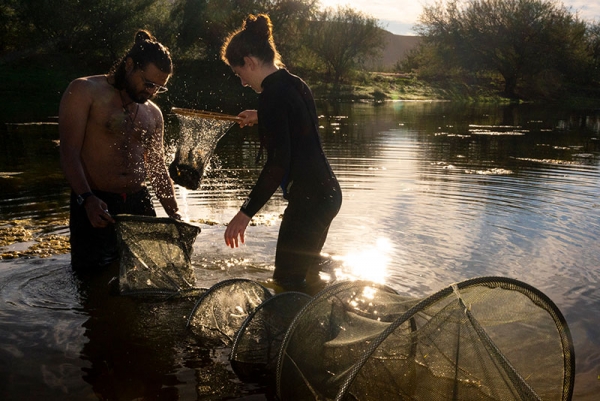
PhD students Cecilia Cerrilla and Mohammed Kajee collect 10-month-old “bass-proof” sandfish.
“A combination of extreme rainfall events and drought appear to have played a key role in the decline and subsequently prevented recovery,” said Cerrilla.
Her study showed that small sandfish were almost entirely absent from the ‘invaded’ section of the Oorlogskloof but relatively abundant where the non-native species were absent. Improved water resource management and limiting the spread of non-natives must be conservation priorities, she said.
Taking fish to water
With the cooperation of local landowners and conservation bodies, human chains can be seen at dams moving white buckets of sandfish along, from bakkie to water.
“We’ve recruited five sanctuary dams now at four different properties, close to the Biedouw River in the catchment area,” said Cerrilla.
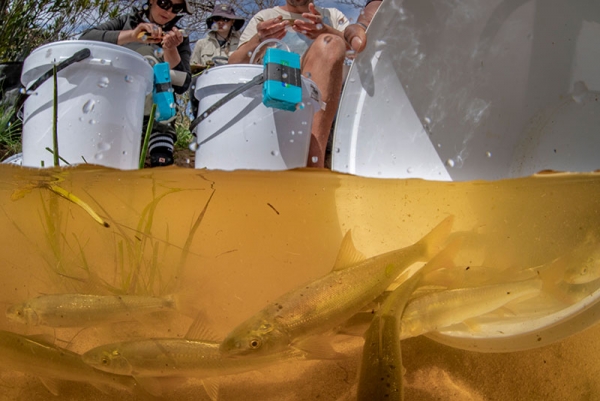
Ten-month-old sandfish that were rescued from the Biedouw River and reared in sanctuary dams are tagged using tiny PIT tags and released back into the river.
Filling in missing habitat
“But in the end, we’re going to have to do something about the alien fish and the water. “Localised eradications must be considered. And it’s already happen[ing] where alien fish have been cleared from a 4 km stretch of the Rondegat River in the Cederberg, which is home to three native fish species.”
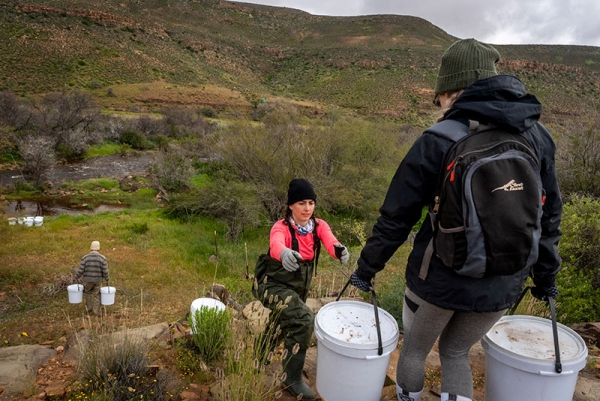
Cecilia Cerrilla, part of the human chain transporting year-old sandfish back to the Biedouw River.
This is the first section of a South African river to be rehabilitated through the removal of invasive fish using the piscicide rotenone.
“It’s complicated, but it’s not impossible,” said Cerrilla
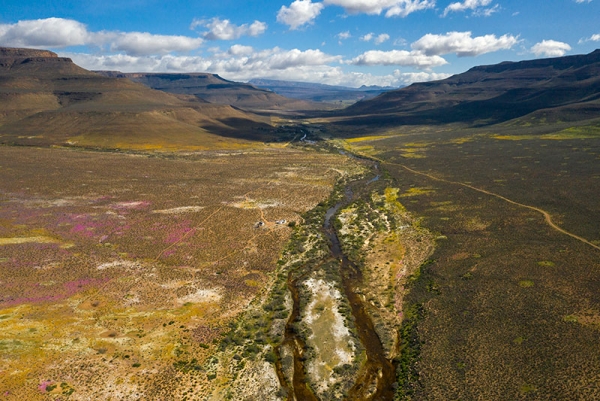
The Biedouw River valley in spring when the sandfish undertake their annual spawning migration
There is hope. In wet years tiny sandfish have been spotted in the shallow pools along the Biedouw River, she said. Last year she carried out extensive walking surveys during spawning season in September to document the migration.
“We saw around 180 adult fish migrating up the Biedouw and witnessed several spawning events. It’s great news that some sandfish are still returning to spawn.”
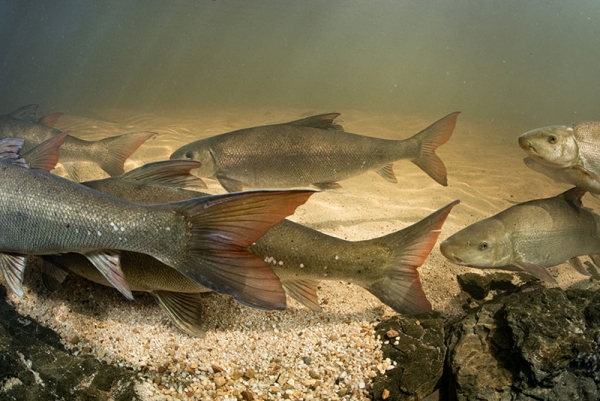
Clanwilliam sandfish are endemic to only one South African waterway.
Cecilia Cerrilla’s co-authors on the recently published paper include Jeremy Shelton and Otto Whitehead, producers of the mini-series on the sandfish, or locally known “onderbekvis”, found in the Doring River and its tributaries, the Biedouw and Oorlogskloof rivers. Video Fishwater Films, co-created by Jeremy Shelton and Otto Whitehead.
Project funders include the National Geographic Society, Mohammed Bin Zayed Species Conservation Fund, IUCN Save Our Species (co-funded by the European Union), the Ford Wildlife Foundation, and the Rufford Foundation. Partners include the Fynbos Fish Trust, CapeNature, the Northern Cape Department of Environment and Nature Conservation, Mount Ceder, Bushmans Kloof, Enjo Nature Farm, Driehoek Guest Farm, Federation of South African Flyfishers (FOSAF), Investec and Caleo Capital.
Story: Helen Swingler
Photos: Jeremy Shelton
